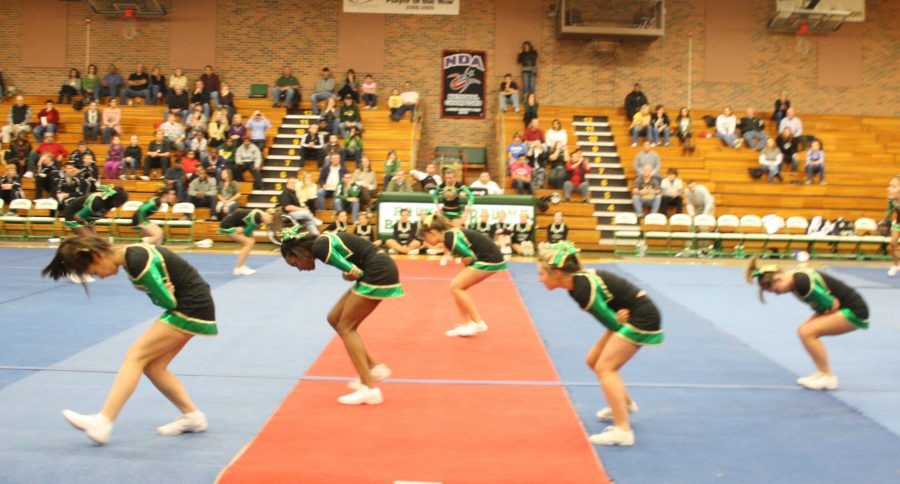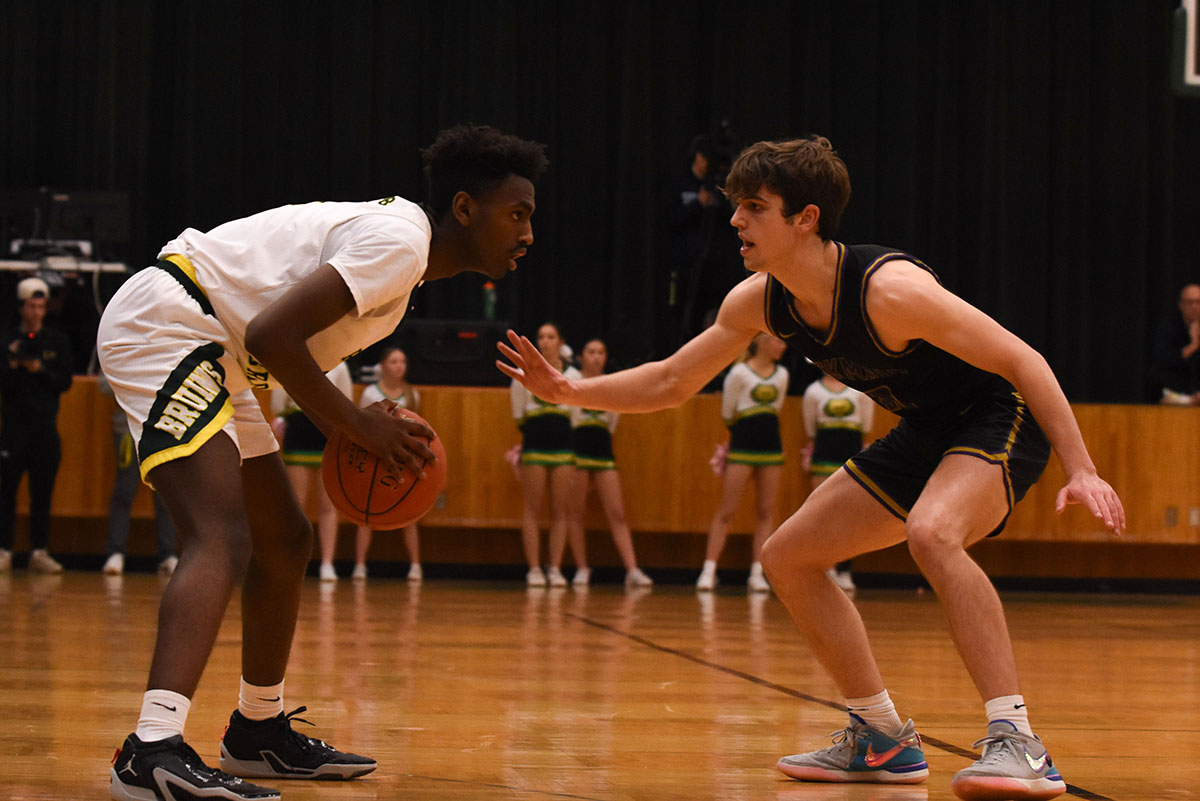
photo by Paige Kiehl
At almost every football game, soccer game, basketball game and assembly, cheerleaders perform stunts most people wouldn’t dare attempt in their dizziest daydreams.
The cheerleaders that are hoisted into the air on one leg to cheer at almost double their height are the fliers, and the girls that do the hoisting are the bases.
Sophomore Lexi Cassimus has been a flier for two years and said she received a couple injuries during her career. Although she has experienced this downside, Cassimus said the fliers aren’t the only cheerleaders who get injured. She said the bases get kicked in the face just as much as she gets dropped and falls.
“It’s pretty dangerous, I’d say. I’ve been dropped a couple times, you know, and gotten hurt, but it’s just part of cheer,” Cassimus said. “I rely on my bases a lot … they’re holding me up, and if they can’t hold me up then I can’t stay up there. But it’s also part my fault if I fall too — it’s kind of 50-50.”
The chance of injury can be high, sophomore flier Lily Burns said, especially for fliers in cheerleading. Burns said many of the cheerleaders have had at least some ankle or wrist injury. The National Center for Catastrophic Sports Injury Research study proved that cheerleading is the most dangerous sport for women. Research at the University of North Carolina reported that 65.2 percent of all catastrophic injuries in youth sports occur in cheerleading.
Not only that, but that cheerleading is more dangerous than all the other women’s sports combined. And according to the United States Sports Academy, cheerleading ranks the second most catastrophic sport for injuries when compared to all sports, only following football.
Even though just a fraction of the cheerleaders are fliers and risk getting injured through stunts, Burns said almost everyone on the squad has gotten injured, whether it be a concussion or just a small ankle injury from tumbling.
Burns also stated it’s pretty common for at least one cheerleader to be down in the trainer’s room, but that being a flier is safe if one knows the ropes.
“I think if you’re smart about it and you know what you’re doing, then you’ll be fine,” Burns said. “The only time I’ve ever gotten hurt is when I sprained my ankle earlier this year, and that was just because I came down wrong. It’s usually not the fault of the bases if you’re getting hurt, it’s more of just everything happens really fast and there’s no way to sometimes stop someone from falling or stop someone from pushing up too hard.”
Even though sometimes there’s not much prevention from a fall, size and weight are usually what depicts a flier. The smaller the flier, the easier it is for the bases to hold them up and help them do stunts, Burns said.
But height isn’t the most important detail of being a flier; Burns said “anyone can be a flier just as long as you can pull up and keep yourself up and people can push you up.”
Asssistant Cheerleading Coach Seth Coliver said with the right technique, flying becomes a lot less dangerous. With any physical activity, there’s going to be the risk of injury, and Coliver added especially with cheerleading, the possibility of injury is higher because bases are picking up fliers and fliers are performing stunts off the ground.
“We stunt in a way that is technically sound to make it as safe as possible,” Coliver said. “When we stunt, we have people standing around the stunt that are watching the stunt and we call those ‘general spotters’ and they are there in case the girl falls. So if the girls in charge of the stunt can’t get to her, they can come in and lend an extra hand to help her out.”
As well as safety procedures, Coliver said the cheerleading coaches teach a many different techniques to successfully execute the stunts in a secure fashion. He said the coaches only allow stunting when there is a coach present and when the girls stunt, they stunt on padded mats so that if they fall, there’s a cushion.
“We also teach [the fliers] how to fall safely and fall correctly,” Coliver said. “If you fall out of a stunt and you start flailing your arms and start freaking out a little bit, you’re going to be throwing elbows and kicking … but we teach to hold tight, focus on your core and put your arms up so that way when you come down. It’s much easier for the girls to catch you.”
The reason cheerleaders continue performing stunts is the same reason every athlete risks what he or she does for their sport, Coliver said. He said it’s because they’re passionate about their sport and their own personal drive to fly or stunt is stronger than the chance of harm.
“You know, football players go out onto a field and they risk getting hurt because they’re getting hit by other men. Basketball players risk getting hurt, too,” Coliver said. “You love your sport, and you love what you do and you do them in spite of the risks. So, I think these girls truly enjoy what they’re doing and it’s the sport that they’ve chosen, and it’s for the love of it that they go through the risk to be in the air.”
By Julia Schaller
















































































![Sophomore Ellie Barnett smiles big as she prepares to begin the second part of the Bruins' routine. Barnett believes the team is ready to compete at state. "This year we have gotten better at mostly everything," Barnett said. "If we just don’t get nervous then everything we have will go [to state with us]."](https://bearingnews.org/wp-content/uploads/2018/11/DSC_0612-e1543590364236.jpg)


Kelsey Lyman • Mar 19, 2013 at 10:32 am
The bases in the picture are Freshman Kelsey Lyman and Sophomores Rebecca Stannard and Erin Houk.